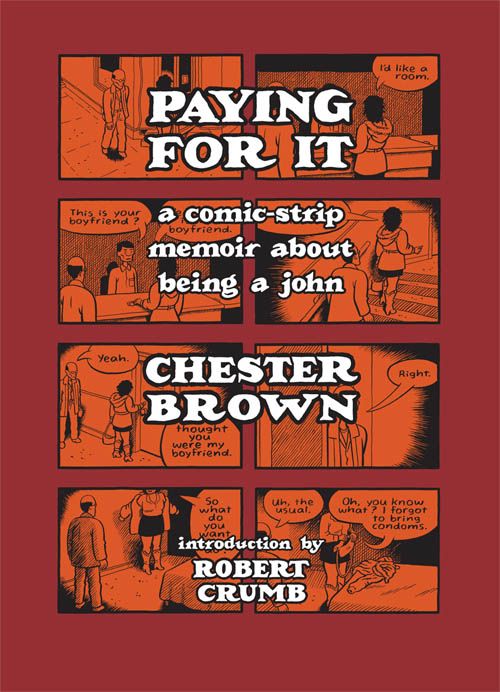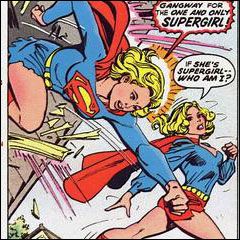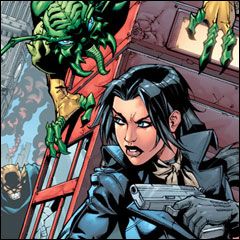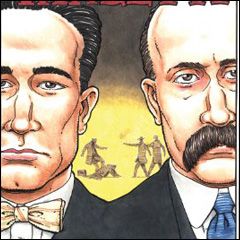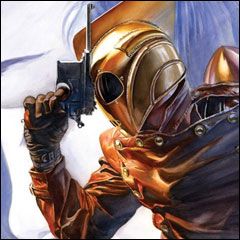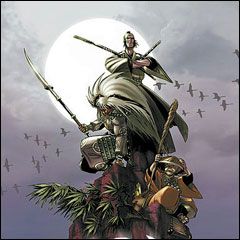Hello and welcome to another edition of What Are You Reading? Today's special guest is Shannon Wheeler, New Yorker cartoonist and creator of the Eisner Award-winning comic book Too Much Coffee Man, Oil & Water, the Eisner-nominated I Thought You Would Be Funnier and the upcoming Grandpa Won’t Wake Up.
To see what Shannon and the Robot 6 crew have been reading, click below ...
*****
Tom Bondurant
Last week my brother-in-law was in a used bookstore -- actually, I guess "used-book store" would be more accurate -- and called me asking what random old DCs and Marvels I'd like. One of the fruits of his labors was September-October 1980's Superman Family #203, a decent little anthology inked mostly by Vince Coletta (so they all tended to look the same) and written and penciled by various DC stalwarts. The lead was a Supergirl story, "The Supergirl From Planet Earth," written by Jack C. Harris and penciled by Win Mortimer. Seems there's a formerly-comatose blonde teenager in Kara's old hometown Midvale who suddenly starts manifesting Kryptonian powers and zipping around in a certain blue-skirted super-suit. Moreover, when questioned by Supergirl, the new kid pretty much recites Kara's first speech to her cousin, about the destruction of Argo City, etc. Naturally I was reminded of Peter David and Ed Benes' "Many Happy Returns" storyline, but Harris and Mortimer only have 12 pages to introduce another complication and then resolve everything -- and resolve it they do, using X-Kryptonite, a medallion made of lead, and some conveniently-placed acid. It's a neat little story which, although inconsequential in the greater scheme of things, is still entertaining.
Since I'm always interested in how a Lois Lane solo series might work (once more), I read "Lost," another 12-pager, written by Marv Wolfman and penciled by Bob Oksner. As with the Supergirl story, there's a lot of plot in these pages: Lois is kidnapped and mind-wiped, escapes, gets picked up by a helpful widower, falls in love with same, and then uses her (unwiped) martial arts skills to fight off the goons who eventually catch up with her. The story ends with an amnesiac Lois wandering off into the woods, Bruce-Banner-style, so I'll have to seek out #204 to see how it ends. Here, I'm not sure the format does this story many favors (especially with regard to Ted, the widower). It might do better played out over a few issues of that hypothetical solo title. (That would also leave room to cross over and/or be mentioned in the main Superman books, too....)
Finally, "The Critic Killer" (written by E. Nelson Bridwell and penciled by George Tuska) is a tale of the Earth-2 Lois and Clark, set in the early '50s when the two were newly married -- and when TV was still new enough that the Daily Star didn't have its own critic. Along comes Lana Lang, daughter of a professor Clark knew from Smallville, seeking to carve out some column space for just that purpose. Clark (editor of the Star, like you didn't know) gives her the job, and she promptly goes all scorched-earth on the new sitcom from a notoriously thin-skinned writer. Lois realizes nothing good can come of Lana's scathing review, and sure enough, the writer traps Lana and Lois in a specially-modified elevator car. Because Lois -- in what strikes me as a bit of Earth-2 Superdickery -- is wearing a "mood ring" which telepathically alerts Clark to sudden changes in her emotions, Superman saves them (of course). However, we learn that the writer bought his elevator-trap from Luthor, still in prison but still scheming about taking down Superman. Dun dun dunnnn! Again, it was a clever little tale whose eight pages were more concerned with establishing Lana's bona fides (this was apparently the retcon introducing Lana to Lois and Clark) and maybe making Lois a little jealous, than with a straightforward adventure/suspense story. Along those lines, it laid the groundwork for future stories involving Lana and/or Luthor, and I'm now curious to see how fleshed-out the "Mr. And Mrs. Superman" stories got.
And speaking of Earth-2, I read Invaders Classic Volume 1, written by Roy Thomas (who else?), penciled mostly by Frank Robbins, and inked by Vince Coletta and Frank Springer. This paperback reprinted the first several issues of The Invaders, plus ancillary issues, and it's pretty much non-stop action from page one. Essentially, the Invaders -- Captain America and Bucky, the Human Torch and Toro, and the Sub-Mariner -- fight Nazi super villains, as depicted by Robbins' hyperkinetic pencils. What I took away from this book, though, was that even though he was working at Marvel, and even though DC was, at the time, doing contemporary Earth-2 stories featuring the Justice Society, Roy Thomas desperately wanted to write a wartime JSA book. I have no idea how much Thomas drew from those old Timely comics to come up with the various Axis bad guys and the heroic Liberty Legion (although reprinted text pages help out in this regard) -- but there sure are conspicuous references to moving "faster than a speeding bullet" and being part of "seven soldiers" of something-or-other. Actually, I take part of that back -- the first baddies the Invaders face are a trio of faux-Teutonic godlings, and I thought "oh, here's a riff on Evil Thor." Still, though, the Liberty Legion contains 1) a speedster, 2) a guy who stretches, 3) a superheroine with black hair and a red-and-blue costume, 4) the Blue Diamond, who kinda looks like Green Lantern if you squint, 5) a flying guy with big bird-wings on his back, 6) Jack Frost, an ice-based hero who looks like he's got Aquaman-style scales, and 7) the Patriot, another red-and-blue-clad figure who's the group's moral center. Maybe it was just me, but I had more fun looking for those kinds of references than I did reading the stories themselves. Lucky for the series, though, the last couple of issues introduce Union Jack and Baron Blood, a British hero and his undead foe, and The Invaders starts to build its own little corner of Marvel history, instead of reminding readers of others'. Lucky for Roy Thomas, too, that it wouldn't be long before he was writing DC's All-Star Squadron -- otherwise, I suspect his brain might have exploded.
(By the way, I'm not up on Marvel history as much as some -- but doesn't Union Jack's debut in World War I make him Marvel-Earth's first costumed hero, preceding the Human Torch by at least 20 years?)
Michael May
As I said in this week's Food or Comics, I wasn't sure if I was going to buy Lois Lane and the Resistance or not. I flipped through it in the store though and decided to get it for its visuals and action sequences. It looked like fun. And there were some exciting parts, but unfortunately, this still isn't the Lois Lane comic I'm waiting for. Lois spends the entire issue running around doing the bidding of other people. The story opens with Perry White's sending her on a fluff piece instead of covering the impending war. The Lois Lane I want to read about doesn't get sent to cover Fashion Week. She doesn't have to whine and argue that she's a serious reporter; everyone should know that she is and treat her that way. But this Lois...even when the story gets going she's still acting as someone else's agent, and not even a particularly competent one. This isn't the story of a strong, empowered reporter that I've been craving.
I also read Mystery Men #2 and liked it, but it reminded me why I became a trade-waiter. The first issue got me all excited to continue the story, but now I'm growing impatient with its being rationed out in small chunks. Some cool stuff happens this issue -- another masked hero joins the investigation and there's a major revelation about the villain -- but it's hard to say that I enjoyed this particular chunk of the story as its own, self-contained unit.
Finally, I read the first volume of Jason DeAngelis and Aldin Viray's Captain Nemo, a manga re-telling of 20,000 Leagues Under the Sea. There are some cool, imaginative things going on in it, like the story's taking place in an alternate timeline where Napoleon won at Waterloo and has taken over the world. The 19-year-old son of the original Captain Nemo is operating the Nautilus II in rebellion against the French Empire, providing this version with an actual plot (something that Jules Verne's novel lacks). Viray's obviously had a great time creating the steampunk world for the story; the environment of the book looks great. And I like how it's still hitting major beats in Verne's story, but reworking them enough to keep them exciting and follow DeAngelis' plot.
But the book falls victim to some standard manga tropes and the characters are boringly familiar. Nemo is the classic manga hero: handsome, but stand-offish, but really very gentle at heart. Camille Pierpont (who stands in for Professor Aronnax, Conseil, and Ned Land by ending up prisoner on the Nautilus II after Nemo saves her from drowning) is the traditional manga heroine: headstrong, judgmental, entitled, but supernaturally gifted with wild animals and really just one good kiss away from calming down into someone likeable. Even the characters' designs are unimaginative; something that Aldin admits to in the sketchbook section where he says that he gave Nemo "the standard Harlock look" and Camille "the typical female lead character look." The other crew members of the Nautilus II are just as immediately recognizable: Smart and Cocky Guy With Glasses, Bad Attitude Girl, Plucky Kid, etc.
Brigid Alverson
This week was murder, at least in terms of what I have been reading. I got an advance copy of Rick Geary's latest Treasury of Victorian Murder book, The Lives of Sacco and Vanzetti, which will be debuting at San Diego Comic-Con this year. Like all of Geary's books, it's cool, almost clinical, with the timelines and details carefully laid out in a heavy-bordered grid and a narrative voice straight out of a PBS documentary Geary's objective voice suits the story well, because the guilt or innocence of Sacco and Vanzetti is a matter of some controversy, but it does make the book seem rather dry.
Also on the stack is The Green River Killer, written by Jeff Jensen and illustrated by Jonathan Case. Jensen's father was a detective on the case, and the story is told from his point of view. The story gets rolling with Gary Ridgeway's confession and skips back and forth in time as the police bring him to the sites of the murders and then flash back to their first encounters with the same scenes. The art is straightforward and linear, but there are some nice atmospheric moments.
And in the prose realm, I'm reading The Poisoner's Handbook, which would be more aptly titled "The Toxicologist's Handbook." Set in 1920s New York, the book follows the work of pioneering medical examiner Charles Norris and toxicologist Alexander Gettler as they investigate various murders -- grouped by the poison involved. Some they solve, some they don't, and sometimes they are simply frustrated by the difficulty of proving their toxicological case in court. It's a bit overly dramatic but a good read nonetheless, and I'm learning a bit of chemistry from it too.
Tim O'Shea
Rocketeer Adventures #1 and #2: OK, I have to admit, I completely missed the first issue's release. So I picked up issue #2 this week, Mark Waid teamed with Chris Weston, Darwyn Cooke, Geof Darrow, Lowell Francis with Gene Ha (all colored by Dave Stewart) and realized: "you were a fool to miss issue #1." Fortunately I snagged the last copy of issue #1 at my local store. And I am torn which is my favorite from that issue, it's a close race between John Cassady colored by Laura Martin or Kurt Busiek teamed with legendary Michael Kaluta (honorable mention Mike Allred colored by Laura Allred). But after serious consideration I have decided that Kaluta (inked by Stewart) is my favorite. There's not a bad story in either issue--and I am looking forward to issue #3.
Thunderbolts #159 is a double-sized issue with multiple creative teams on different tales. But all you need to know is this: Jen Van Meter writes a team-up (of sorts) between Ghost and John Walker. I really hope that Marvel announces some more work for Van Meter at San Diego, because she deserves a monthly assignment.
Captain America: Given Bucky's current status quo (given the Fear Itself event), I am confused as to why I would care what happened to James in this issue. But all my annoyance washed away when I got to see Chris Samnee draw more Nick Fury in the second half of the issue.
Did you catch my interview with Roger Langridge about the preview of his new Kaboom book, Snarked #0, which will sell for $1 in August? Did I convince you to tell your retailer to get a copy for you? You have until June 30 for the Previews deadline (Diamond Code: JUN110963). I mean it when I commit to this series being destined for my best of 2011 books.
Shannon Wheeler
Paying for It
There’s a narrow road to success if a creator already has a lot of good books. If it’s too different from what came before, I’ll hate it, and if it’s too similar to what came before, then I’ll hate it, too. Chester Brown created my favorite comics: Ed the Happy Clown and The Playboy. So, of course, I was disappointed with Paying for It.
It’s an autobiographical book about Chester Brown's decision to satisfy his sexual needs by being with prostitutes. The best part of the book is when he details his internal conflict and anxiety when he first hires women to have sex with him. Unfortunately, the book drags as he uses his friends as characters to stage pro and con arguments regarding prostitution. The books drags even more when he reiterates his beliefs for the third… and fourth time. He avoids talking about his final relationship in respect for her desire for privacy. This could have been an emotional resolution in the book -- Chester finding a relationship that he’s comfortable with. They are both happy with monogamous, but independent, lives where he continues to pay for sex. Any editor could have trimmed 20 percent of the redundant ranting to make it a smoother read and then pushed for a conclusion with emotional depth and acute observations similar to the book’s beginning. Chester Brown could have had a book that matched or succeeded his earlier work. As it stands, the book is a vaguely interesting read as a political diatribe and an okay read as an emotional journey, but is redundant as one and unresolved as the other. Chester is still a great creator; it’s too bad his editor hasn’t kept pace. It’s a good book that could have been a great book.
Okko
It’s a solid read that takes place in old Japan with demons, ronins, monks and magic. The book is skillfully put together with natural storytelling, attractive drawings and pretty coloring. It’s not a book you’ll ponder much after putting it down. As a book in the same genre as the great Usagi Yojimbo, it holds up as a solid and entertaining read.
New Yorker: On the Money
I always grab collections of New Yorker cartoons. This one has the strength of being assembled by the New Yorker’s current cartoon editor, Bob Mankoff. By choosing financially themed comics from 1925-2009, Mankoff shows an economic history of our country through humor. It’s telling that the rich-screw-the-poor is a recurrent theme that doesn’t change from the earliest comics to the recent ones. The repetition left me a little cold. Maybe not cold - but depressed. If the economics of this country could change the way families, gender roles and race relations have changed, I might like the book better. But I guess that’s not really the book’s fault.
Cowboy Wally
Always funny. I’m constantly amazed at how well this book has held up. I consider it one of the best comics created.
Underground
I just picked this one up, but the first issue shows potential. I love the art and story. Jeff Parker and Steve Lieber are great comic creators. I’m sure they’ll deliver.


